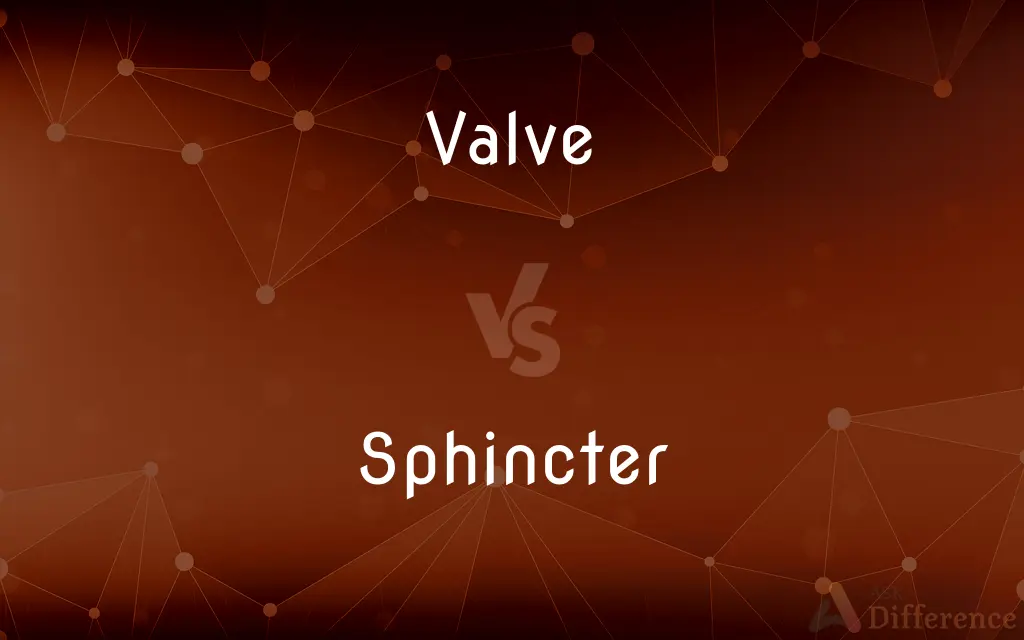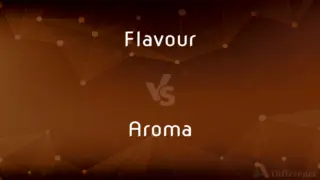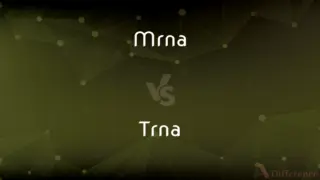Valve vs. Sphincter — What's the Difference?
By Tayyaba Rehman — Updated on October 29, 2023
A valve is a device regulating the flow of fluids, while a sphincter is a ring-like muscle controlling passage through an opening.

Difference Between Valve and Sphincter
Table of Contents
ADVERTISEMENT
Key Differences
Valves are mechanical or biological devices that regulate, direct, or control the flow of fluids by opening, closing, or partially obstructing passageways.
Sphincters are muscular structures in the body that act like valves but are specifically ring-like muscles that contract to close an opening.
In context, a heart valve controls blood flow, whereas the esophageal sphincter controls the passage of food to the stomach.
While valves can be artificial or part of biological systems, sphincters are exclusively biological and involve muscle contractions.
Valves and sphincters both serve the purpose of controlling flow but in different contexts and with different mechanisms of action.
ADVERTISEMENT
Comparison Chart
Nature
Mechanical or biological
Strictly biological
Function
Regulate fluid flow
Control passage through an opening
Structure
Can vary; includes flaps, gates, etc.
Ring-like muscle
Mechanism
Opening, closing, or obstructing passageways
Muscle contraction to close an opening
Location Examples
Heart valves, pipes, engines
Esophageal sphincter, anal sphincter
Compare with Definitions
Valve
A device regulating flow.
The plumber fixed the leaky valve.
Sphincter
Involved in bodily functions.
The anal sphincter plays a crucial role in defecation.
Valve
A valve is a device or natural object that regulates, directs or controls the flow of a fluid (gases, liquids, fluidized solids, or slurries) by opening, closing, or partially obstructing various passageways. Valves are technically fittings, but are usually discussed as a separate category.
Sphincter
Controls openings in the body.
A strong sphincter muscle is essential for continence.
Valve
A device for controlling the passage of fluid or air through a pipe, duct, etc., especially an automatic device allowing movement in one direction only
A valve shuts off the flow from the boiler when the water is hot enough
Sphincter
Contracts to close.
The sphincter contracts during swallowing.
Valve
Each of the halves of the hinged shell of a bivalve mollusc or brachiopod, or of the parts of the compound shell of a barnacle.
Sphincter
Manages passage through channels.
The urinary sphincter controls urine release.
Valve
Any of various devices that regulate the flow of gases, liquids, or loose materials through piping or through apertures by opening, closing, or obstructing ports or passageways.
Sphincter
A circular muscle.
The esophageal sphincter prevents acid reflux.
Valve
The movable control element of such a device.
Sphincter
A sphincter is a circular muscle that normally maintains constriction of a natural body passage or orifice and which relaxes as required by normal physiological functioning. Sphincters are found in many animals.
Valve
A device in a brass wind instrument that can be opened or closed to change the pitch by altering the length of the air column in the tube.
Sphincter
A ringlike muscle that normally maintains constriction of a body passage or orifice and that relaxes as required by normal physiological functioning.
Valve
(Anatomy) A membranous structure in a hollow organ or passage, as in an artery or vein, that folds or closes to prevent the return flow of the body fluid passing through it.
Sphincter
(muscle) A ringlike band of muscle that surrounds a bodily opening (such as the anus or the openings of the stomach), constricting and relaxing as required for normal physiological functioning.
The sphincter of the bladder
The iris sphincter in the eye
Valve
A piece of shell covering or enclosing certain mollusks or other invertebrates, especially the single one of a univalve mollusk or one of the paired hinged ones of a bivalve mollusk or brachiopod.
Sphincter
A muscle which surrounds, and by its contraction tends to close, a natural opening; as, the sphincter of the bladder.
Valve
One of the two siliceous halves of the cell wall of a diatom.
Sphincter
Of, pertaining to, or designating, a sphincter; as, a sphincter muscle.
Valve
One of the pieces into which a plant part splits at maturity, especially a segment of a fruit capsule or of certain anthers.
Sphincter
A ring of muscle that contracts to close an opening
Valve
Chiefly British An electron tube or a vacuum tube.
Valve
(Archaic) Either half of a double or folding door.
Valve
To provide with a valve.
Valve
To control by means of a valve.
Valve
A device that controls the flow of a gas or fluid through a pipe.
Shut off the valve
Open the valve
Valve
A device that admits fuel and air into the cylinder of an internal combustion engine, or one that allows combustion gases to exit.
Valve
(anatomy) One or more membranous partitions, flaps, or folds, which permit the passage of the contents of a vessel or cavity in one direction, but stop or control the flow in the opposite direction
The ileocolic, mitral, and semilunar valves
Valve
One of the leaves of a folding-door, or a window-sash.
Valve
(British) A vacuum tube.
Valve
(botany) One of the pieces into which certain fruits naturally separate when they dehisce.
Valve
(botany) A small portion of certain anthers, which opens like a trapdoor to allow the pollen to escape, such as in the barberry.
Valve
(biology) One of the pieces or divisions of bivalve or multivalve shells.
Valve
(biology) One of the two similar portions of the shell of a diatom.
Valve
(transitive) To control (flow) by means of a valve.
Valve
A door; especially, one of a pair of folding doors, or one of the leaves of such a door.
Swift through the valves the visionary fairRepassed.
Heavily closed, . . . the valves of the barn doors.
Valve
A lid, plug, or cover, applied to an aperture so that by its movement, as by swinging, lifting and falling, sliding, turning, or the like, it will open or close the aperture to permit or prevent passage, as of a fluid.
Valve
One or more membranous partitions, flaps, or folds, which permit the passage of the contents of a vessel or cavity in one direction, but stop or retard the flow in the opposite direction; as, the ileocolic, mitral, and semilunar valves.
Valve
One of the pieces into which a capsule naturally separates when it bursts.
Valve
One of the pieces or divisions of bivalve or multivalve shells.
Valve
A structure in a hollow organ (like the heart) with a flap to insure one-way flow of fluid through it
Valve
Device in a brass wind instrument for varying the length of the air column to alter the pitch of a tone
Valve
Control consisting of a mechanical device for controlling the flow of a fluid
Valve
Controls fluid direction.
A heart valve ensures blood flow in the correct direction.
Valve
Can be mechanical or biological.
An artificial valve was implanted during surgery.
Valve
A flow obstruction device.
The safety valve prevented the pressure from getting too high.
Valve
Operates by opening or closing.
The valve opens when the temperature rises.
Common Curiosities
Is a sphincter a type of valve?
In a broad sense, sphincters function like valves but are specific to biological systems.
Can a valve regulate gas flow?
Yes, valves can regulate the flow of gases as well as liquids.
Do all sphincters control fluid flow?
Sphincters mainly control the passage of solids, liquids, and gases in the body.
Are valves found in all types of machinery?
Valves are common in many machines, especially those involving fluid dynamics.
Is the function of a sphincter always involuntary?
Some sphincters are under voluntary control while others are involuntary.
Can a sphincter be surgically repaired?
Yes, there are surgical procedures to repair or strengthen sphincters.
Are valves only found in the heart?
No, valves can be found in various biological and mechanical systems.
Can valves be manually operated?
Yes, some mechanical valves are designed for manual operation.
Are artificial valves always made of metal?
No, artificial valves can be made of various materials including metal, plastic, or bioprosthetic materials.
Do valves require maintenance?
Mechanical valves may require maintenance, but biological valves do not.
Can sphincters become weak?
Yes, sphincters can weaken due to various factors including age and health conditions.
Can exercise strengthen sphincters?
Certain exercises can help strengthen some sphincters.
Is it possible to have a prosthetic valve?
Yes, prosthetic valves are commonly used in heart valve replacement surgeries.
Do valves play a role in regulating pressure?
Yes, many valves are crucial for maintaining appropriate pressure in systems.
Are all sphincters circular?
Yes, sphincters are typically ring-like or circular muscles.
Share Your Discovery

Previous Comparison
Flavour vs. Aroma
Next Comparison
mRNA vs. tRNAAuthor Spotlight
Written by
Tayyaba RehmanTayyaba Rehman is a distinguished writer, currently serving as a primary contributor to askdifference.com. As a researcher in semantics and etymology, Tayyaba's passion for the complexity of languages and their distinctions has found a perfect home on the platform. Tayyaba delves into the intricacies of language, distinguishing between commonly confused words and phrases, thereby providing clarity for readers worldwide.














































